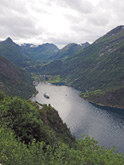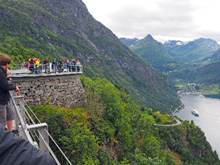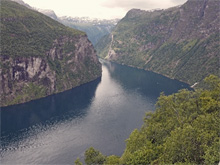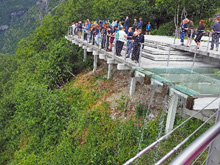July 29, 2016 Geiranger, Norway Hard to imagine a more dramatic entrance.
I sightsee to experience new places and people. I was not looking forward to a trip to the fjords because the towns would likely be all the same - or almost so. I was right - they are and were. But I realized that with respect to a trip like this, I had put my focus on the wrong object. I love the mountain states of the U.S. but the towns don't hold my interest for any length of time. Instead, I need to focus on scenery first and towns second. As in the U.S. Rockies, the scenery in Norway both varied and spectacular. This trip has made me aware that the scenery can make a place worthwhile for me, and therefore the towns a bit more enjoyable as well (I'm not saying that this is an earthshaking realization - just mine).
We stopped at a place for a coffee and Danish. The place was named DJUPVASSHYTTA. If I gave you the same letters in Scrabble, you'd quit. For a finale, the bus took us up another road along the side of the fjord where there were only 11 hairpin switchbacks. We got a view of the same fjord but from another angle. I earlier mentioned that we saw lots of waterfalls as we cruised in this morning. But this afternoon I saw a waterfall the likes of which I'd never seen before. The last photo below shows a glass or plastic ledge (right hand side of the photo) over which water runs and then falls onto a rock face below. We're at the same altitude as in the third photo below.     In short, Geiranger looked like paradise to live in - if you ignored the winters. However, the guide shared another story about the town. Down the fjord about 10 miles is a huge rock slab that is slowly separating from the mountain it's part of, slipping downward toward the fjord at the rate of an inch or so a year. If that slab falls into the fjord it will create a wave/tsunami high enough to swamp the town under a hundred or more feet of water. The Norwegian government has installed some sort of an early warning alarm system in and around this slab in case it develops larger cracks, or starts slipping more quickly or, heaven forbid, starts to fall. The Geiranger-ites would have about seven minutes to scramble up the hill in back of the town to escape the wave. Someone asked our guide about emergency services. She mentioned that the nearest medical help for anything serious was at least two hours travel away by car and ferry. Her advice: Stay healthy my friend. |